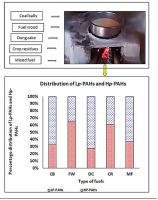Atmospheric Pollution Research ( IF 4.5 ) Pub Date : 2021-07-15 , DOI: 10.1016/j.apr.2021.101142 Madhuri Verma 1 , Shamsh Pervez 1 , Judith C. Chow 2, 3 , Dipanjali Majumdar 4 , John G. Watson 2, 3 , Yasmeen Fatima Pervez 5 , Manas Kanti Deb 1 , Kamlesh Shrivas 1 , Vikas Kumar Jain 6 , Noor A. Khan 7 , Papiya Mandal 7 , Rajan K. Chakrabarty 8

|
In South Asia, combustion of solid fuel for residential heating and cooking is a major emission source of particulate-phase polycyclic aromatic hydrocarbons (p-PAHs), a potent carcinogen for human health. The emission factors (EFs) and source diagnostic ratios of PAHs currently used in regional inventory models have been estimated from controlled laboratory tests, which do not accurately reflect real-world combustion scenarios observed in rural Indian households. Consequently, the health effects associated with p-PAH levels in indoor and ambient air could be severely underestimated and undervalued. We performed a nationwide study across ten different states in the Indian subcontinent to evaluate the EFs and source diagnostic ratios of sixteen U.S. Environmental Protection Agency (EPA) identified high priority p-PAHs emitted from residential solid biomass combustion. Our estimated average annual EFs were 2.4–18.3 fold higher than those reported from previous laboratory-based investigations. Carcinogenic toxicity analysis shows that combustion of dung cake and coal ball, both widely used residential solid fuels, posed the most risk (80% and 59% respectively) in comparison to other PAHs owing to predominant emission of benzo[a]pyrene. Our findings underscore the importance of improved laboratory testing and field validations as crucial steps toward more accurate emission inventories and better assessment of public health impacts.
中文翻译:

评估南亚住宅固体燃料燃烧产生的 PM2.5 多环芳烃排放量及相关健康危害
在南亚,用于住宅取暖和烹饪的固体燃料燃烧是颗粒相多环芳烃 ( p- PAHs)的主要排放源,它是一种对人类健康的强致癌物。目前在区域清单模型中使用的 PAH 的排放因子 (EF) 和源诊断比率是根据受控实验室测试估算的,这不能准确反映在印度农村家庭中观察到的真实燃烧场景。因此,与p相关的健康影响- 室内和环境空气中的多环芳烃水平可能被严重低估和低估。我们在印度次大陆的 10 个不同州进行了一项全国性研究,以评估美国环境保护署 (EPA) 确定的 16 个高优先级p的 EF 和源诊断比率- 住宅固体生物质燃烧排放的多环芳烃。我们估计的年均 EF 比以前基于实验室的调查报告的 EF 高 2.4-18.3 倍。致癌毒性分析表明,与其他多环芳烃相比,粪饼和煤球这两种广泛使用的住宅固体燃料燃烧造成的风险最大(分别为 80% 和 59%),因为主要排放苯并[a] 芘。我们的研究结果强调了改进实验室测试和现场验证的重要性,这是实现更准确的排放清单和更好地评估公共卫生影响的关键步骤。


























 京公网安备 11010802027423号
京公网安备 11010802027423号